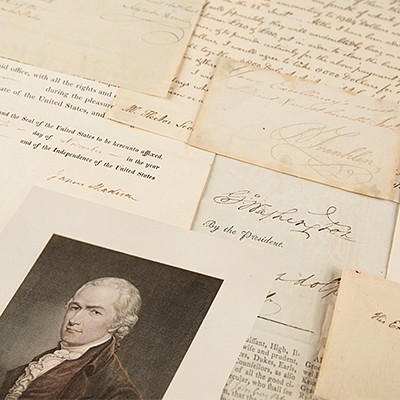Henry Miller (4) Autograph Manuscripts Signed on Friends and Influences
Two ways to bid:
- Leave a max absentee bid and the platform will bid on your behalf up to your maximum bid during the live auction.
- Bid live during the auction and your bids will be submitted real-time to the auctioneer.
Bid Increments
| Price | Bid Increment |
|---|---|
| $0 | $5 |
| $50 | $10 |
| $200 | $25 |
| $500 | $50 |
About Auction
Oct 11, 2023
RR Auction support@rrauction.com
- Lot Description
Four autograph manuscripts signed by Henry Miller, totaling 24 pages, 8.5 x 11, no date but circa 1970s. Miller pens four character studies of figures from his personal life, entitled "Camilla," "Melpo," "Aunt Anna," and "Abraham Rattner." The first three were published in Henry Miller's Complete Book of Friends, and the last was a eulogy given by Miller before the American Academy and Institute of Arts and Letters.
"Camilla" begins: "Her full name was Camilla Euphrosnia Fedrant. She had black blood in her veins, or should I say white blood? I thought of her as a mulatto, a term one doesn't hear anymore for people of mixed blood. At the time I was the employment manager of the Messenger Dept. of the Western Union Telegraph Co. in N.Y. City. Camilla was my assistant. How she got this job I have completely forgotten. I believe that she had appealed to the President of the Telegraph Company." He goes on to describe his close working relationship with her and a racist experience in the workplace, resulting in her resignation and his quitting the job himself.
"Melpo" begins: "Shortly after I returned from Greece I became a guest at the home of Gilbert and Margaret Neiman in Beverly Glen. The house they occupied was just a little shack off the road. It was there I began making watercolors for anything you wanted to give me—a dollar or two, an old coat, a pair of shoes, anything whatever. I was in terrible straits due to the banning of the books I had written in France. The idea of taking a job never occurred to me. I just kept on writing and painting little watercolors at night." He goes on to relate his friendship with an elegant Greek woman who enjoyed his travelogue 'The Colossus of Maroussi,' and her generous offer of patronage: "Well aware of my poverty stricken condition, Melpo nevertheless pretended not to be aware of it. Until one day I received a telephone call from her. It was almost a monologue. The burden of it was that she could no longer bear to see me living in such poverty, I who was one of the greatest writers in the world. I who had done so much for her people, and she who was so wealthy and had need of nothing." Overwhelmed, he declined to accept her generosity but remained a dear friend.
"Aunt Anna" begins: "I must have been between twelve and fourteen years of age when Aunt Anna, as my mother called her, first appeared on the horizon. Actually she was not my aunt, nor my mother's. Perhaps she may have been something like a second cousin to my mother‰Û_.She was simply angelic, not of this world. I suppose she was what is called beautiful, but I was impressed by other qualities which were not exclusively feminine. In short, she was of the airs, as the Greeks would say, a creature not only ethereal but possibly celestial‰Û_All my life I wittingly or unwittingly have used Anna as a yardstick to detect others of her ilk. I have even had the great good fortune to live with one or two. Just as we can spot a holy man by the lustrous spherical orbs in his head so we can detect the presence of the angelic ones, no matter how they dress or look or behave."
"Abraham Rattner" begins: "It was my great privilege to meet Abe Rattner in the early days of my Paris sojourn. He was a warm, loyal friend from beginning to end. Easy to get along with, tres sympatico, generous and understanding. In contrast to his explosive, dynamic canvases, he himself was mild and complacent. But within him raged a volcano which poured forth endless fire and flame in his work. He was a completely sincere, dedicated artist. He worked like a slave, giving all of himself and a little more to boot." Curiously, the second page is a photocopy of Miller's handwritten text.
Offering unique insight into Miller's friends and influences, these published manuscripts form a remarkable collection of his stylish semi-autobiographical prose. In overall fine condition. - Shipping Info
-
Bidder is liable for shipping and handling and providing accurate information as to shipping or delivery locations and arranging for such. RR Auction is unable to combine purchases from other auctions or affiliates into one package for shipping purposes. Lots won will be shipped in a commercially reasonable time after payment in good funds for the merchandise and the shipping fees are received or credit extended, except when third-party shipment occurs. Bidder agrees that service and handling charges related to shipping items which are not pre-paid may be charged to a credit card on file with RR Auction. Successful international Bidders shall provide written shipping instructions, including specified Customs declarations, to RR Auction for any lots to be delivered outside of the United States. NOTE: Declaration value shall be the item’(s) hammer price and RR Auction shall use the correct harmonized code for the lot. Domestic Bidders on lots designated for third-party shipment must designate the common carrier, accept risk of loss, and prepay shipping costs.
-
- Buyer's Premium



 EUR
EUR CAD
CAD AUD
AUD GBP
GBP MXN
MXN HKD
HKD CNY
CNY MYR
MYR SEK
SEK SGD
SGD CHF
CHF THB
THB















